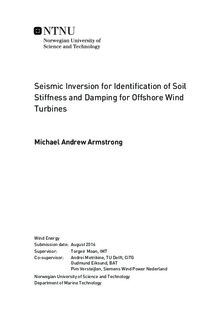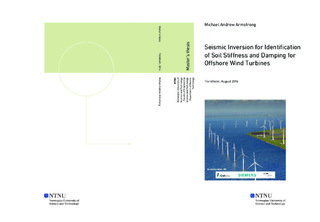| dc.contributor.advisor | Moan, Torgeir | |
| dc.contributor.advisor | Metrikine, Andrei | |
| dc.contributor.advisor | Eiksund, Gudmund | |
| dc.contributor.advisor | Versteijlen, Pim | |
| dc.contributor.author | Armstrong, Michael Andrew | |
| dc.date.accessioned | 2019-09-11T08:50:13Z | |
| dc.date.available | 2019-09-11T08:50:13Z | |
| dc.date.created | 2016-08-23 | |
| dc.date.issued | 2016 | |
| dc.identifier | ntnudaim:16090 | |
| dc.identifier.uri | http://hdl.handle.net/11250/2615000 | |
| dc.description.abstract | Non-invasive in-situ measurements can determine the soil properties in an undisturbed way, providing a more accurate characterization of the soil stiffness and damping. This report focuses on the multichannel analysis of surface waves (MASW) technique. The measured dispersion of a propagating seismic wave is used to characterize the variation of small-strain soil stiffness with depth while a modified halfbandwidth method is used to estimate the intrinsic soil damping variation with depth. Both require solving an inversion problem with a global optimization strategy. The equations governing wave propagation in layered visco-elastic media are used to form a analytic forward model. Sensitivity studies are performed and it is found that for a soil damping ratio below 10%, the migration of the real part of the wavenumber is minor. Therefore, a decoupled approach is used, where the soil stiffness is estimated first, followed by an estimation of the soil damping. The modal dispersion curves are shown to be very sensitive to the shear wave velocity of the soil, especially in the near surface layers. This is desirable as this sensitivity allows for a more accurate inversion. Additionally, there is a high sensitivity to the layer thickness of the model and it is shown that the discretization of the model, especially near the surface, has a large impact on the predicted modal dispersion curves. To estimate the stiffness profile, modal inversion is performed with a genetic algorithm. The misfit function is based on the determinant of the secular function, including a determinant normalization. Synthetic inversions were first applied to verify that the technique is successful. Surface wave data from the Westermeerwind offshore wind farm is analyzed and several estimates are made for the stiffness profile versus depth using different inversion settings. It is shown that these estimates agree well with a seismic cone penetration test (SCPT) estimate for the same site. An inversion is also performed on a set of measurements taken at the North-Sea Gjøa site. It is shown that the inversion is in good agreement with the published predictions for the stiffness at this site. The damping profile is inverted based on a modified half-power bandwidth method.A wavelet compression is used to select a smart set of root locations which leads to an efficient and balanced inversion. Synthetic inversions show that the method is successful in estimating the soil damping profile. The damping inversion technique is very promising and the next step should be taken to apply this to the measured data from the Gjøa and IJsselmeer sites. | en |
| dc.language | eng | |
| dc.publisher | NTNU | |
| dc.subject | Wind Energy, Offshore Engineering | en |
| dc.title | Seismic Inversion for Identification of Soil Stiffness and Damping for Offshore Wind Turbines | en |
| dc.type | Master thesis | en |
| dc.source.pagenumber | 186 | |
| dc.contributor.department | Norges teknisk-naturvitenskapelige universitet, Fakultet for ingeniørvitenskap,Institutt for marin teknikk | nb_NO |

